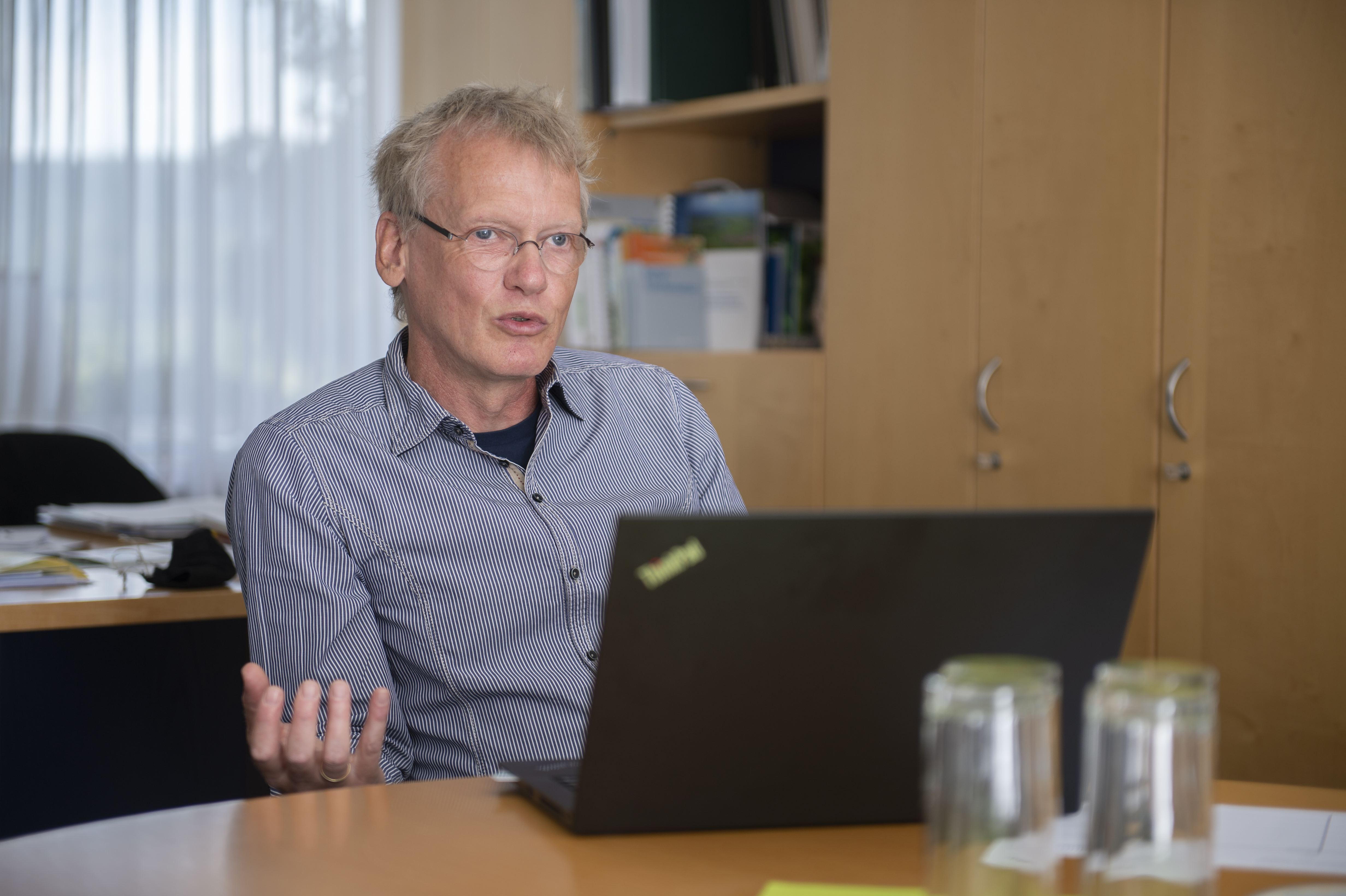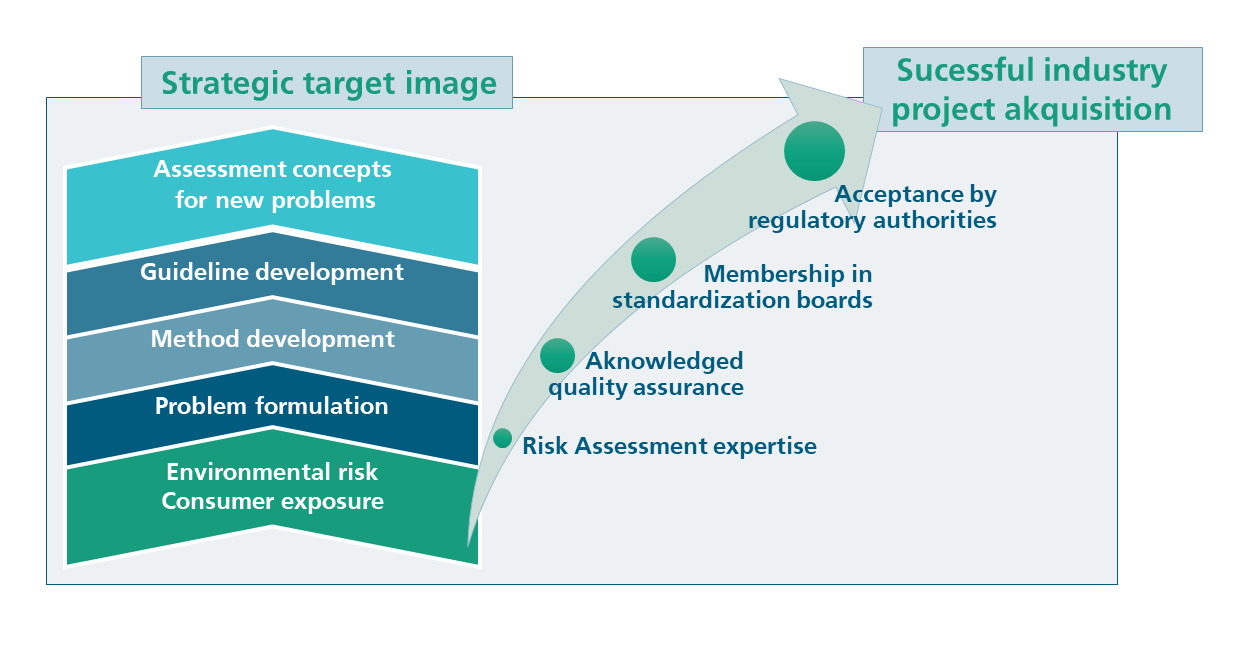Contact Press / Media
Prof. Dr. Christoph Schäfers
Director
Fraunhofer Institute for Molecular Biology and Applied Ecology IME
Auf dem Aberg 1
57392 Schmallenberg, Germany
Phone +49 2972 302-270

Prof. Schäfers, when did you start at Fraunhofer?
After studying biology in Münster and Mainz and completing my doctoral studies in ecotoxicology, I had my first job in 1992 at the Institute for Biochemical Research and Analysis IBFA, where I designed the advanced training course in environmental analysis and ecotoxicology for engineers and scientists and initially ran it on my own. I contacted the Fraunhofer institute in Schmallenberg to illustrate the theory in practice. During the visit in 1994, an artificial stream facility was also presented, which coincidentally corresponded exactly to the vision I had developed during my diploma thesis, and a postdoc position for one year was considered for this annex, for which I automatically applied.
In order to fulfil the responsibilities of my course at the IBFA, I was able to start with a half-time position at Fraunhofer Institute for Environmental Chemistry and Ecotoxicology IUCT for two years. This meant that I had a longer period of time available for a field study covering all seasons, including preliminary planning and evaluation. The IBFA had to close its Quedlinburg location after one year, and IUCT gave me the opportunity to support the Federal Environment Agency (UBA) in Berlin for six months with the authorisation of plant protection products. When I returned to Schmallenberg in 1996, I was given a laboratory management position to utilise the experience I had gained.
What has boosted your career the most?
It certainly helped to be open-minded and self-confident enough to seize opportunities as they arose, to take responsibility for what I was given and to make the best of them. At the same time, I was always lucky to meet superiors who, in addition to their knowledge, placed a lot of trust in me and gave me the freedom to shape things: at the University of Mainz Prof. Alfred Seitz and Prof. Roland Nagel, at the IBFA Dr. Joachim Sonnenberg, at Fraunhofer IUCT Prof. Werner Klein, at the German Environment Agency (UBA) Dr. A.W. Klein and at Fraunhofer IME Prof. Andreas Schaeffer and my colleague Prof. Stefan Schillberg. Another prerequisite was being motivated and a member of motivating teams in Mainz, Quedlinburg and Schmallenberg.
How does the business model of the division Applied Ecology work?
Our topics are the environmental risk assessment of substances and the assessment of consumer exposure to substances in the environment. To this end, we work with regulatory authorities and industry associations to identify problems that can be addressed with the help of scientific data. We develop specific methods for reproducible data collection and evaluation, from overview screening and targeted studies to environmental simulation and modelling. We then transfer these methods and data into developing and validating guidelines. Our proven expertise in risk assessment and our recognised quality assurance are just as important for our commercial success as our active involvement in standardisation committees and the acceptance of our excellent science by industrial customers and regulatory authorities (Fig. 1).

What guidelines have been and are being developed in Schmallenberg?
As a member of the OECD (Organisation for Economic Co-operation and Development) fish drafting group, the IME-AE takes a leading international position in the development of chronic fish studies. We are involved in the revision, development and/or validation of the following guidelines:
Dr. Matthias Teigeler is in charge of the development and validation of the ZEOGRT (Zebrafish Extended One Generation Reproduction Test)
Dr. Sebastian Eilebrecht is currently investigating the validity of the transcriptomic Point of Departure (tPOD) as an alternative to the chronic No Effect Concentration as part of an European Chemicals Agency (ECHA) project.
Prof. Dr. Christian Schlechtriem made significant contributions to the recording of bioaccumulation and metabolism in fish (to create the basis for evaluation in consumer protection):
Dr. Markus Simon is involved in the development and modification of water-sediment tests with aquatic plants, mosquito larvae, amphipods and annelid worms. Protocols for testing Water Accommodated Fractions (WAF), column elution or passive dosing methods have been and are being developed for handling substances and mixtures that are difficult to test.
Dr. Monika Herrchen, Dr. Boris Meisterjahn and Dr. Dieter Hennecke developed the experimental basis for determining biodegradation in liquid manure in the Ecological Chemistry department and Dr. Boris Meisterjahn continues to be active in standardisation in the Nanomaterials section:
The degradation behaviour of chemicals in water, water/sediment and soil (OECD 309, 308, 307) on a laboratory scale was further developed in Schmallenberg by Dr. Prasit Shrestha in order to be able to investigate substances that are difficult to test. The transport of substances by rainwater in so-called lysimeters (undisturbed soil cores) was co-developed in Schmallenberg in the 1990s by Dr. Werner Kördel. The institute and Karlheinz Weinfurtner played a key role in the development of the TSCF (Transpiration Stream Concentration Factor) for determining uptake via the roots.
The dTOP assay (Direct Total Oxidizable PFAS) developed by Dr. Bernd Göckener is becoming the standard analytical method.
Among other things, Dr. Michael Klein developed the Pesticide Leaching Model (PELMO), which is currently used to determine the mobility of substances.
You are largely financed by industry contracts. What about independence?
The Fraunhofer-Gesellschaft is a non-profit organisation. Although we have a high proportion of industry funding, our largest single customer is the Federal Environment Agency (environmental specimen bank, guideline development). Our contract studies are funded by industry, but must be accepted by the regulatory authorities. We organise training courses for regulators (German Environment Agency (UBA), ECHA) to point out critical points in the conduct of studies. Our orientation must be strictly scientific, and the assessment by the authorities is then based on the precautionary principle. The strict confidentiality of industry studies must be maintained under all circumstances and this is extremely important for us since we have all of the world's largest pesticide manufacturers as clients.
How does the institute management cover the various research areas and Fraunhofer IME locations?
All locations have essential topics that are based in agricultural production: be it biological plant protection, the use of insects for nutrition, the development of contained farming systems and cultured meat, proteome research to optimise the material composition in plant cells or the risk assessment of fertilisers, veterinary drugs and plant protection products in the environment and food. There are a number of methodological overlaps. Cell metabolism and the use of molecular methods now play an important role in all fields. This is why we are currently formulating Agrinomics, a portal of topics and methods for all molecular interactions in connection with agricultural production, and opening up a systemic view of them. Keywords for Food and Health are Nutrigenomics, Toxicogenomics and Venomics, for environmental issues Exposom and Ecotoxicogenomics.
How will Fraunhofer IME be positioned in the context of the Fraunhofer-Gesellschaft in the future?
Our IME Agrinomics focus deals with the basic biological-chemical processes of the bioeconomy and creates the basis for process engineering applications. This unique selling point offers the other Fraunhofer institutes of the competence-related Fraunhofer Group for Resource Technologies and Bioeconomy (VRB) docking opportunities. At the same time, it enables joint offers within the market-related Fraunhofer Agriculture and Food Industry Alliance.
The Fraunhofer Chemistry Alliance institutes' realisation of the need for technology assessment and regulatory substance evaluation for environmental safety increases the importance of the IME and opens up new opportunities for cooperation, while the environment is still underrepresented in the Fraunhofer Health Alliance.
Prof. Schäfers, you are already in your 7th decade of life. What goals do you still have?
In my last four years as head of the institute, I am primarily concerned with developing integrative topics and creating structures in the sense of preserving biodiversity as the most important parameter of sustainability. Scientifically, I would like to advance the recording and evaluation of immunoecotoxic effects and establish molecular effect screening to predict population effects. The latter can be used, for example, in a future circular economy for the assessment of recyclates. I would like to hand over the IME-AE as a leading scientific institution in regulatory environmental risk assessment. For the entire IME, I would like to develop Agrinomics as a common portal for a systemic view of agricultural production, its products (food, natural pharmaceuticals, renewable raw materials) and the possibilities and consequences of cultivation and utilisation for people and the environment. For the Fraunhofer-Gesellschaft and human society as a whole, I would like to contribute to moving away from an ideology of growth that over-exploits resources and towards a climax economy inspired by ecological principles.